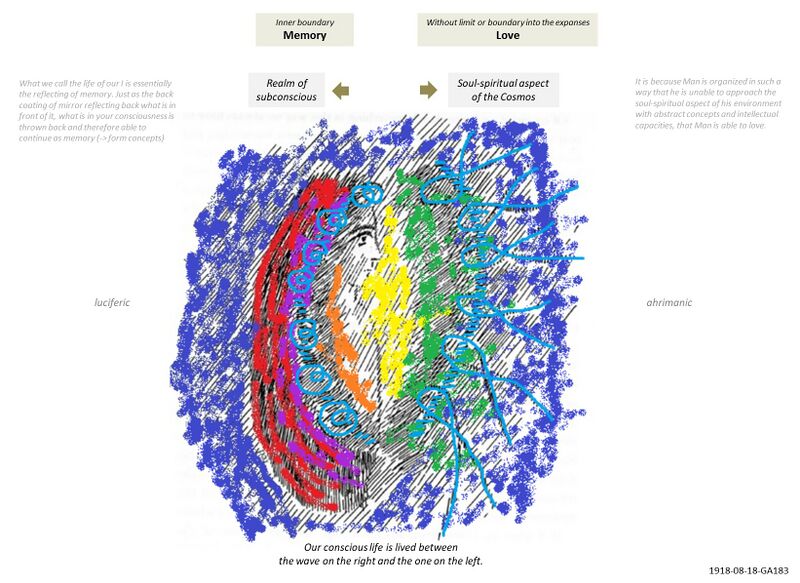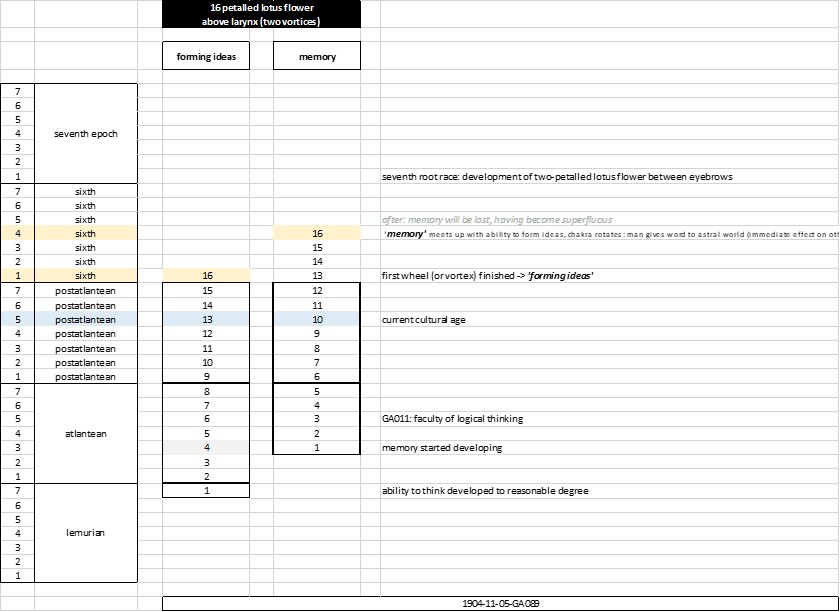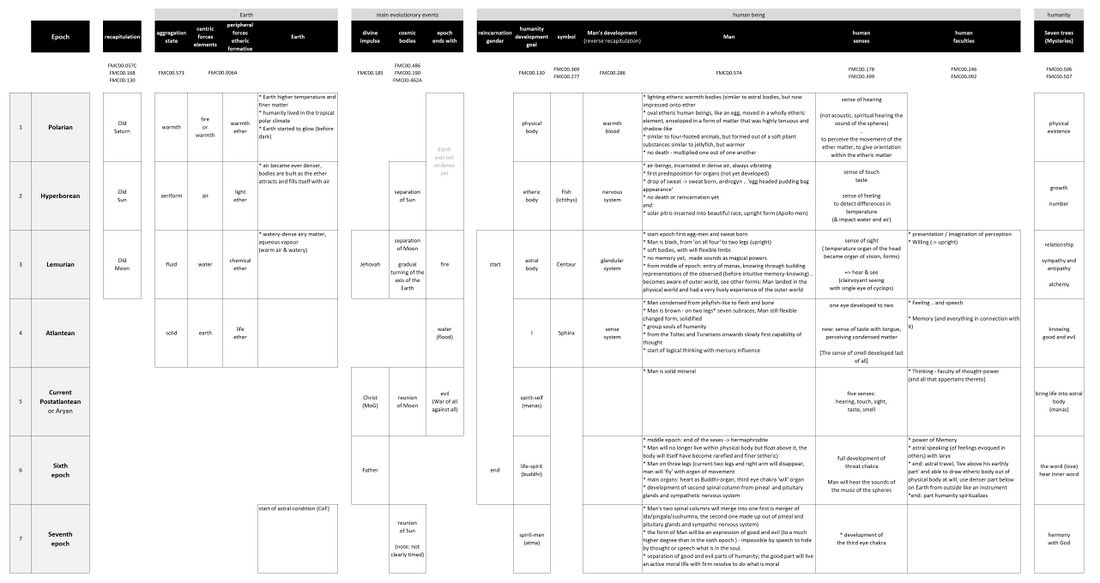Memory and love
The human faculties of memory and love are latent future human faculties that will develop, following the three current faculties of the Human 'I' and threefold soul: thinking feeling and willing (TFW), or as they are described in order of appearance in the child as well as Man in its evolutionary path across epochs: Walking Speaking Thinking (WST), as:
- Walking upright through the force of Willing developed in the Lemurian epoch,
- Speaking or speech through the force of Feeling developed in the Atlantean epoch
- Thinking developed in the Current Postatlantean epoch.
Rudolf Steiner describes that the ancient faculty of intuitive Memory will be developed as a conscious spiritualized faculty in the Sixth epoch (see oa Schema FMC00.092 and Schema FMC00.584, see also Walking Speaking Thinking#M - memory.
Aspects
- Memory and love can be said to correspond as Earthly faculties to the spiritual in- and out-breathing during death and a new birth - see more on Rhythmic pattern between death and new birth. Memory is being-within-ourselves, Love is the echo of what we pour out in the world. Or put differently: whereas between death and a new birth there is a rhythm between turning inward (memory, connected with human egoism and human freedom) and going outward (morality, he outcome of experiencing love, a result of communion with higher hierarchies); here on Earth the experiences come to expression, not as a rhythm, but as two co-existing human faculties: the faculty of love and the faculty of memory (1922-12-15-GA219)
Illustrations
Schema FMC00.229B: shows a simplified picture of Schema FMC00.229 focusing on the aspects of memory and love (based on 1918-08-18-GA183).
This is further elaborated end in the lectures of end 1922, see Memory and love.
In the process during death and a new birth these are experienced as a rhythm between inner reflection (memory connected with human egoism and human freedom) and outer connection (morality, the outcome of experiencing love, is a result of communion with higher hierarchies). Here on Earth these experiences come to expression, not as a rhythm, but as two co-existing human faculties: the faculty of love and the faculty of memory.
Schema FMC00.092: sketches the natural timeline of anticipated development of the throat chakra. Note the link with the twelve subraces or cultural ages represented by the twelve apostles, that end with the second cultural age of the sixth epoch. Lecture 1906-10-04-GA091 describes this exact period for the Christ to come fully into power and humanity starts to understand Christ. For the development of the faculty of memory, see 1914-03-07-GA152 on Walking Speaking Thinking.
Schema FMC00.584: provides a overview and synthesis table over the Earth's seven epochs and the overall evolutionary pathway for Earth and humanity, as a map for orientation across the many separate topic pages and Schemas. For a more graphical presentation, see Schema FMC00.486. This is a first tentative version, to be iteratively improved in the future. Click one to three times to enlarge or go to page for download at full resolution.
Lecture coverage and references
Coverage overview
A full lecture is dedicated to ‘memory and love’ with 1918-08-18-GA183.
Alternating rhythms already in 1914-GA153. This is described in 1922-12-04-GA218 and 1922-12-15-GA219
.. after already touching on it as part of WST equivalences (here in Ch 11 as part of 7 year cycles) on 1922-11-26-GA219
Reference extracts
1918-08-18-GA183
lecture titled: The Human Aura. Memory and Love (link 2)
Synopsis
The physical human being's state of separateness from his earthly surroundings; the involvement of man's soul-spiritual being with the streams of his own inner domain of soul and spirit and with those of the universe.
Two poles of man's soul-spiritual nature. The boundary between
- the normal aura and
- the universal dimension of the surrounding world.
Streaming movements as flashes of light, gestures of encounter and opposition; the forming of boundaries, external and internal barriers.
- Memory as an inner barrier or wave of obstruction; beyond this zone lies a conscious inner space.
- The other zone corresponds to the power of love; and beyond this zone is the soul-spiritual aspect of the universe
1922-11-26-GA219
First this is touched upon as part of WST equivalences on 1922-11-26-GA219, see Walking Speaking Thinking
Then, one week later:
1922-12-04-GA218
lecture titled: 'Memory and Love'
In spiritual life between death and a new birth the exact opposite prevails. There we do really know what is within us. It is as if here on earth we were not to see trees and clouds outside, but were to look in the main inside ourselves, saying: Here is the lung, here the heart, here the stomach. In the spiritual world we contemplate our own interior. But what we see is the world of spiritual beings, the world we come to know in our anthroposophical literature as the world of the higher Hierarchies. That is our inner world. And between death and rebirth we feel ourselves actually to be the whole world — when I speak of the whole it is only figuratively, but it is entirely true — at times we each of us feel ourselves to be the whole world. And at the most important moments of our spiritual existence between death and a new birth we feel within us and experience the world of spiritual beings and are conscious of them. It is just as true that we are conscious there of spirits of the higher world within us as it is true that here on earth we have no consciousness of our interior, of liver, lungs, and so on. What is most characteristic is that in spiritual experience all our physical experience is reversed. Gradually, through initiation-knowledge, we learn how this is to be understood.
[An essential (group of) process(es) related to the inward living together with higher Hierarchies]
Now, however, there is an essential process — or group of processes — related to this inward living together with the beings of the higher Hierarchies. Were we in the spiritual world to perceive inwardly only the world of the higher Hierarchies, we would never find ourselves. We would indeed know that various beings were living in us, but we would never become fully aware of ourselves. Hence in our experience between death and a new birth there is a rhythm.
It consists in an alternation between
- our inward contemplation and experience of the world of spiritual beings described in anthroposophical literature,
- and a damping down of this consciousness.
We do the same with the spiritual within us when in physical life we close our eyes and ears and go to sleep. If I may put it like this, we turn our attention from the world of spiritual beings within us and begin to perceive ourselves. Certainly it is as if we were outside ourselves, but we know that this being outside ourselves is what we are. Thus in the spiritual world we alternately perceive ourselves and the world of spiritual beings.
This constantly repeated rhythmical process can be compared with two different things here in physical existence on earth. It can be compared with in-breathing and out-breathing, and also with sleeping and waking.
In physical existence on earth both these are rhythmical processes; both may be compared with what I have been describing. But with the processes that take place in the spiritual world between death and rebirth, it is not a question of knowing something in a purely abstract way, or — I might add — for the satisfaction of spiritual curiosity; it is a matter of recognising life on earth as an image of the super-earthly. And the question necessarily arises:
What takes place in earthly life that is like a faculty of memory such as man does not have in ordinary consciousness, a faculty that might be possessed by beings of the Hierarchies, Archangels?
What is there in physical life that is like a memory of living oneself into the world of spiritual beings, or like a memory of experiencing oneself there?
and later, after expanding on the fact that we find this back, in the physical world, in morality, memory and love .. again in summary
.. I have compared what man experiences in connection with higher beings in the spiritual world, alternating with his experience of the self, with breathing — in-breathing, out-breathing. In our breathing process, and in the processes concerned with speech and song, we can recognise an image of “breathing” in the spiritual world. As I have said, our life in the spiritual world between death and a new birth alternates between contemplation of the inner self, and becoming one with the beings of the higher Hierarchies; looking out from within, becoming one with ourself. This goes on like in-breathing and out-breathing. We breathe into ourselves and then breathe ourselves out, and this is of course a spiritual breathing. Here on earth this breathing process becomes memory and love. And in fact memory and love also work together here in physical earth-life as a kind of breathing. And if with the eyes of the soul you are able to look at this physical life rightly, you will be able to observe in an important manifestation of breathing — speaking and singing — the physiological working together of memory and love.
1922-12-09-GA218
Our Memory here on the Earth is the echo of our being-within-ourselves in the Spiritual World.
And Love, in all its forms, is the echo of our being-poured-out into the world of the Hierarchies.
We have, as we have seen, our bodily faculties: Walking, Speaking, Singing and Thinking (for it is only prejudice to imagine that thought on the earth is a spiritual faculty; our earthly thinking is essentially bound to the physical body, just as our walking is) — these outstanding faculties of the body are transformations, metamorphoses, of the spiritual. Then, in the soul, we have the outstanding faculties of soul: Memory and Love, once more as transformations out of the spiritual.
1922-12-15-GA219
The lecture is called 'Rhythms of Earthly and Spiritual Life. Love, Memory, the Moral Life' and gives a comparison between the two alternating conditions between birth & death, and between death & birth.
It is described
- how morality, the outcome of experiencing love, is a result of communion with higher hierarchies
- and how memory is also very much connected with human egoism on the one side and, on the other, with human freedom. Freedom will become a reality in a human being in whose life on Earth there is a true echo of what is experienced in pre-earthly existence as a kind of rhythm: namely, feeling oneself united with the Beings of the Hierarchies, freeing oneself, entering into union again, and so on.
Here on Earth the experiences come to expression, not as a rhythm, but as two co-existing human faculties: the faculty of love and the faculty of memory.
Two alternating conditions
This faculty is at work, to begin with as a formative force, in our body. In the child, as long as it has no consciousness leading to memory—i.e. in the earliest period of childhood —this stronger creative force still enters into and works with the forces of growth. Then something that is finer, more rarefied, is as it were separated out from these stronger forces—and this is the human faculty of memory.
The fact that here on Earth too man lives primarily in himself, is again connected with this faculty of memory. Memory is also very much connected with human egoism on the one side and, on the other, with human freedom. Freedom will become a reality in a human being in whose life on Earth there is a true echo of what is experienced in pre-earthly existence as a kind of rhythm: namely, feeling oneself united with the Beings of the Hierarchies, freeing oneself, entering into union again, and so on.
Here on Earth the experiences come to expression, not as a rhythm, but as two co-existing human faculties: the faculty of love and the faculty of memory.
But a certain heritage from this rhythm in pre-earthly existence can remain with man. If this is so, then in earthly life too the true relationship will be established in him between memory and love.
- He will be able on the one side to develop understanding, loving understanding of other men.
- And on the other side, from his experience of the world together with other human beings, his own recollective thinking will contribute to his own development, to the strengthening of his own nature.
Discussion
Related pages
- Love
- Memory
- Rhythmic pattern between death and new birth
- Aspects of the passage through the planetary spheres
- Thinking Feeling Willing
- Walking Speaking Thinking
References and further reading
- George Adams: 'Das Rosenkreuzertum als Mysterium der Trinität' (Anregungen zur anthroposophischen Arbeit 9)
- contains essay on 'memory and love'



